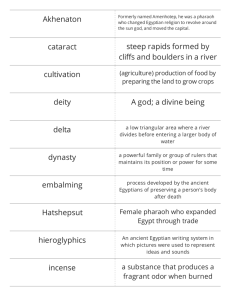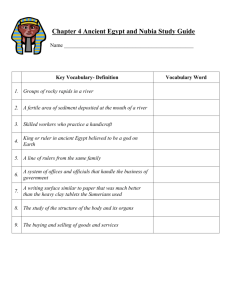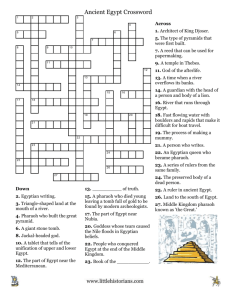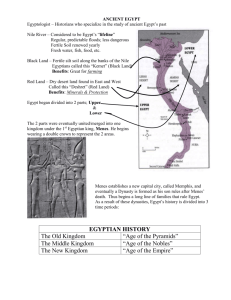1. Find the words to do with Ancient Egypt in the wordsearch below
advertisement
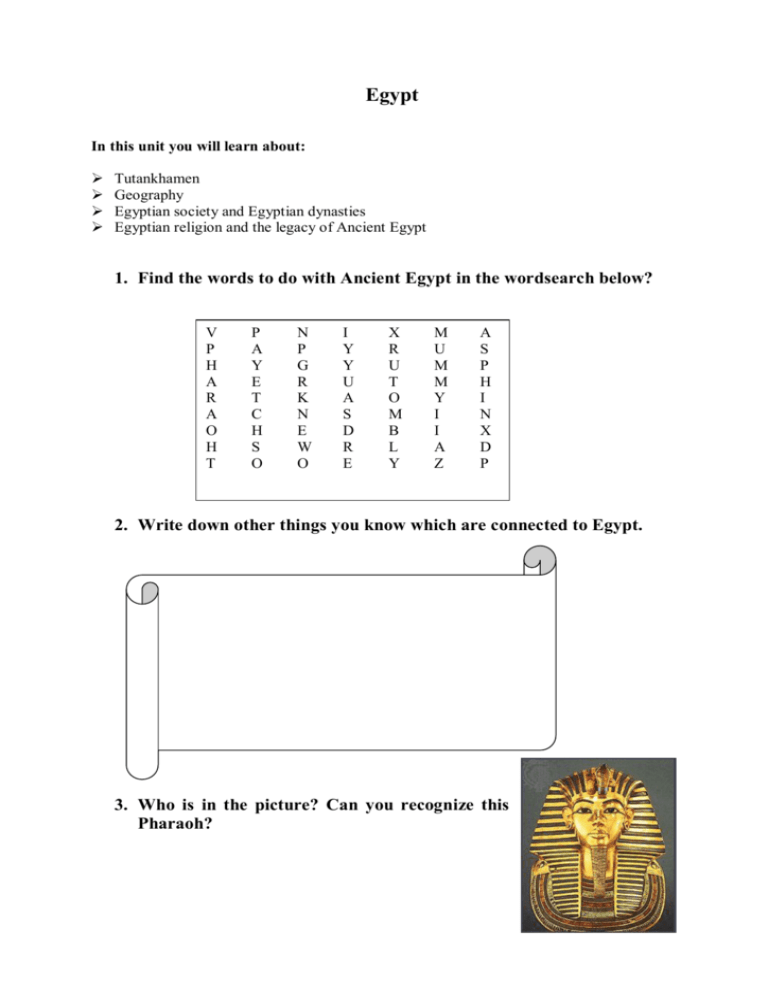
Egypt In this unit you will learn about: Ø Ø Ø Ø Tutankhamen Geography Egyptian society and Egyptian dynasties Egyptian religion and the legacy of Ancient Egypt 1. Find the words to do with Ancient Egypt in the wordsearch below? V P H A R A O H T P A Y E T C H S O N P G R K N E W O I Y Y U A S D R E X R U T O M B L Y M U M M Y I I A Z A S P H I N X D P 2. Write down other things you know which are connected to Egypt. 3. Who is in the picture? Can you recognize this Pharaoh? 1. TUTANKHAMEN 1. Read the following source. Slowly .........the decisive moment had arrived. With trembling hands........ I inserted candle and peered in ..............details of the room within emerged slowly ..................... strange animals, statues, and gold – everywhere the glint of gold. ´Can you see something?´ asked his companion Lord Carnarvon. ´Yes, wonderful things,´ he answered. 2. What is the source about? Discuss it in the class. These are the words of Howard Carter, an archaeologist who made a remarkable discovery in 1922. For three years he searched the ruins of an ancient Egypt burial place. Carter removed ton after ton of rubble. Then one day a worker found a doorway to the tomb of an ancient Egyptian king. Underneath the burial chamber of Pharaoh Ramses VI., a door had been discovered. Behind it lay another door with the seal of Tutankhamen intact. In a room eight metres long and four metres wide there were nearly 60 000 objects which Egyptians believed their Pharaohs might need in after-life. Nearby was a second room which contained the King’s body enclosed in four gold coffins. It was decorated with gold collars, ring and bracelets. On his face was a life- gold mask. Nothing like this had ever been discovered in the Modern Times. People who knew little about Egyptian history now became interested much more. Who were these people who could bury a young man with such riches? The story of Egypt begins........................................ 2. GEOGRAPHY 1. Read the following source aloud. It was written over 3000 years ago by an Egyptian poet. What did the Hymn to the Nile celebrate? Hail to thee, O Nile, that flows from the earth and .........keeps Egypt alive!............ When the Nile rises, then the land is in celebration, then every belly is in joy, every backbone takes on laughter, and every tooth is exposed. (the Hymn to the Nile) 2. Why did early people think a river valley was a good place to live? 3. Look at the map below and find: Nile River Valley Upper Egypt Lower Egypt Suez Canal Delta Mediterrenean Sea Red Sea Sinai Cairo Alexandria Aswan Israel 4. U s e t h e m a p s o v 4.Look at the map above and complete the blank map below. 5. Some of the words in the passage below are missing. Fill them in from the words in the box. crops hot soil dry floods mud mountains of Africa silt longest north delta desert irrigation Egypt is ................. and ..................country in the ..................of Africa. The River Nile runs through the middle of it. The Nile starts in the ........................ and flows down through Egypt into the Mediterranean Sea. Egypt is all ................. apart from the land beside the River Nile. The River Nile is the ..................river in the world. Every year the Nile ....................from July until October. Then water spreads over the land for about twenty kilometres each side of the river. The water carries with rich black ........................ and ...................... When the flood dries up, the land is left covered with a layer of new......................... that was once river-mud. This helps the ..................to grow better. Where the Nile flows into the Mediterranean Sea, the silt created a .................. Egyptians watered their crops every day, so they had to dig channels from the Nile so that water flowed between the fields. This is called..................... 6. Test yourself 1. Is Egypt an island? 2. Is Egypt near the South Pole? 3. Is Egypt near the equator? 4. Is Lower Egypt in southern or northern Egypt? 5. Is Upper Egypt in southern or northern Egypt? 6. Where does the Nile flow into? 7. What is delta? 8. What is irrigation? 9. Which river is the longest in the world? 10. What is the capital of Egypt? 3. EGYPTIAN SOCIETY 1. Who was who? Read the following descriptions and decide who was who? 1. Because the pharaoh could not perform ceremonies at all the temples throughout Egypt, he appointed them to carry out the sacred rituals at each temple. They often passed down their positions from father to son. They enjoyed great power and wealth in Egyptian society. 2. Egypt was one of the wealthiest countries in the ancient world. They (actually, they were more like traders) carried products such as gold, papyrus made into writing paper or twisted into rope, linen cloth, and jewellery to other countries. In exchange, they brought back cedar and ebony wood, elephant tusks, panther skins, giraffe tails for fly whisks, and animals such as baboons and lions for the temples or palaces. 3. He was a powerful ruler and the leader of the Egyptian people. His name means "Great House". He was also called the "Lord of the Two Lands" and "High Priest of Every Temple". The Egyptians saw him as a God. He was the ruler of Upper and Lower Egypt. His crown was white (Upper Egypt) and red (Lower Egypt) to show the unity of the two lands. He made laws and collected taxes, was an army leader and the chief of the temples. He often wore false beards which symbolized royal authority. His main responsibility was to make sure Egypt was protected and at peace. 4. They were highly valued members of Egyptian society. They studied for many years to learn to read and write. They had great opportunities as accountants, priests, doctors, and government officials of all sorts. They kept records of taxes and the activities of pharaohs. They never knew poverty and they were treated with respect. 5. The Egyptian objects that we see in museums today were created by them, employed by the pharaoh, the government, or temples. They worked in large workshops rather than in individual studios as they often do today. Carpentry, metalwork, jewellery making, pottery, sculpture, wall painting, glass making, and weaving are some of the crafts they practiced. 6. They worked lands belonging to the pharaoh, the government, a temple, or a rich landowner. In addition to ploughing, planting, and harvesting, they maintained the irrigation canals that brought water to their fields and were required to work on the pharaoh's tomb construction project each year. 7. The lowest class of Egyptian society, these workers were often foreigners. They worked in the household, pyramids construction projects or in the fields. They could be bought and sold like property. People could also sell themselves into slavery and buy themselves out of it. 8. He was the Pharaoh’s closest advisor. He was the first official like a Prime Minister. 9. They protected Egypt from enemies and they helped to enlarge Egypt. During peace time, they worked on government projects such as digging irrigation canals for farming, or transporting stone for the king's tomb. 2. Test yourself? 1. Who was called Great House? 2. Who was like a Prime Minister? 3. What is slavery? 4. Why were scribes treated with respect? 5. What colours was a Pharaoh’s crown? What did those colours symbolize? 6. Who was the highest priest in Egypt? 7. What was brought by merchants to Egypt from abroad? 8. Why did Pharaohs wear beards? 9. What did soldiers do during peace? 10. Who was considered like a God in Egypt? 4. THE EGYPTIAN DYNASTIES 1. From a village to a united Empire. Read the following article aloud. Wandering hunters first entered the valley about 4 500 BC and settled down in villages. The need to build canals and dams for irrigation made it essential for the people of each village to cooperate. Later on the villages, in order of better organisation of work, joined together to create nomoses or provinces and these created two large kingdoms called Lower Egypt and Upper Egypt. At one time Lower and Upper Egypt were two different kingdoms. A vast desert lay between them. Each was ruled by a different king. The king of Upper Egypt wore a white crown. The king of Lower Egypt wore a red crown. In 3100 BC the king Menes of Upper Egypt united the two kingdoms. From that time on, the kings of ancient Egypt wore a double crown. Menes built the city Memphis for his capital. 2. Explain in your own words how Egypt was united. 3. What was a nomos? 4. Which city was the first capital of Egypt? 5. Read aloud about the List of Rulers. The List of Rulers The basic source for Egyptian history is the List of the Rulers compiled by an Egyptian priest named Manetho who started to write history nearly 3000 years after the reign of the first Egyptian kings. Manetho wrote in Greek in about 280 B.C., after Alexander the Great conquest of Egypt. Manetho divided the kings into thirty dynasties (later chronicles added a thirst-first). Modern historians have accepted the List of Rulers and they have grouped the dynasties into several periods. Period Dynasties Years Archaic 1-2 3100-2700 Old Kingdom 3-6 2700-2200 Intermediate 7-10 2200-2050 Middle Kingdom 11-12 2050-1800 Intermediate 13-17 1800-1570 New Kingdom 18-20 1570-1085 Post Empire 21-31 1085-332 6. Read about the basic periods of Egyptian history. The Old Kingdom The Old Kingdom reached its glory in the Fourth Dynasty, when wealth and prosperity of the Kingdom increased greatly. The significant symbols of this period are three pyramids built at Giza. About 3000 BC the king of the Third Dynasty called Djoser decided to be buried in a tomb made of six mastabas (early Egyptian stone tomb square and flat-topped ) of decreasing size placed one on top of the other. This tomb, which is over 60 metres high, is known as the Step Pyramid The Fourth Dynasty , mostly the kings Khufu (Cheops), Khefre and Menkaure are well-known for their pyramids at Giza. The highest one, Khufu´s Pyramid, is called The Great Pyramid and was built around 2600 BC. Near the Great Pyramid lies the famous Sphinx. This strange statue looks like a lion with a human head and it protected and guarded the Great Pyramid. The First Intermediate Period The Old Kingdom dissolved into a period of general anarchy known as the First Intermediate Period. This period meant an economic and political decline of Egypt. Egypt was dropped into several little dukedoms and ruled by many hardly-known pharaohs. But gradually the anarchy passed away, and kings of the Eleventh Dynasty, centred at the city of Veset (Thebes), reunited Egypt. The Middle Kingdom and the Second Intermediate Period The prosperity and success of the Middle Kingdom declined in the late Twelfth and early Thirteenth Dynasties. The invasion by the Hyksos, about 1720 B.C., ended the Middle Kingdom and led to the Second Intermediate Period. Historians are still not certain who the Hyksos were, but they were probably a group of several western Asiatic peoples from Syria and Palestine. Little is known about these warriors except that they fought in chariots drawn by horses. After nearly a century of wars the Hyksos were driven out of Egypt by Amosis in about 1570 BC. These years of fighting made the Egyptians a more warlike people. While the Hyksos ruled Egypt, the Egyptians learned to ride horses and also some important military skills from them. After that a Theban prince Amosis made himself Pharaoh and a new period the New Kingdom or the Egyptian Empire started. 7. Test yourself 1. When was Egypt united? 2. Who united Egypt? 3. What is the name of source telling us about the Egyptian dynasties? 4. Who compiled that source? 5. Which periods does the history of Egypt consist of? 6. Which capitals of Egypt have you learnt so far? 7. What was mastaba? 8. Which Pharaoh ordered to build the first pyramid? 9. Who was buried in the Great Pyramid? 10. What protected and guarded the Great Pyramid? 11. What caused the fall of the Middle Kingdom? 8. Fill in the missing words. The Hyksos invaded Egypt in the year ............. and they were driven out around the year...................by ............. The Hyksos were the peoples coming from........................... The Egyptians learnt from them....................... and how to ride ................................... 9. Read about the New Kingdom and the most famous Egyptian Pharaohs. The New Kingdom Egypt reached the greatest achievements during the Eighteenth Dynasty (1580 – 1310). The rulers of Thebes established the power of the central government and organized Egypt into a military state. They enlarged their territory into Asia Minor where they met another large kingdom, the Hittite Empire HATSHEPSUT I have repaired what was destroyed, I have raised up what was in pieces ever since the Asiatics had been in the Delta, overthrowing what had been made. During the rule of Hatshepsut, Egypt traded with many faraway places. As a result, Hatshepsut greatly enriched Egypt’s wealth. She was known to send peaceful trading expeditions to East Africa and Asia. Egyptian traders returned with ivory, gold, and spices. The temples she ordered built at Thebes are among the greatest buildings of Ancient Egypt. She had herself portrayed as a sphinx with a beard to emphasize her right to rule as the king. THUTMOSE III. When Hatshepsut died Thutmose III. became a Pharaoh. In an act of revenge against her long domination over him, Thutmose III. had her name erased from as many monuments as possible. He made about 17 military expeditions into Asia Minor and he enlarged the Empire as far as the River Euphrates. He ordered to place many obelisks carved with the stories of his battles in Karnak. AKHNATON Early in his reign Pharaoh Amunhotep IV began to oppose Amun-Ra, for centuries the traditional God of Thebes, and sponsored the worship of the Aton. This was also supported by his wife Nefertiti, rumoured to be the prettiest woman of Egypt. To advertise the new faith among his people, he changed his own name to Akhnaton that meant he who serves Aton and sent workers around Egypt to erase the name of Amun-Ra from monuments. He moved his capital from Thebes to a completely new city called Akhetaton where he built a temple to Aton and lived rather like a Pope serving his God. Some historians called him the first monotheist. Akhnaton neglected the kingdom. Nobles took advantage of his inattention and seized the independence. And even more, first in Syria and then in Palestine, Egyptian control was put down. The Asiatic holdings fell away. Akhnaton´s religious reform did not survive after his death and his successors returned back to the traditional religion. Every mention of Akhnaton and his God Aton was erased in the temples and palaces. The town Akhetaton was destroyed. RAMSES II. The New Kingdom now emerged from its weakness and was led by such great Pharaohs as Ramses II. He fought a great battle with the Hittites in 1285 BC at Kadesh in Palestine. The conflict continued until the two kingdoms signed a peace treaty in 1284. As the result of this treaty Ramses II married to a Hittite’s princess and the river Orontes became the common border of these two most powerful kingdoms. the peace allowed Ramses II. to spend time and money on building projects. His great achievement was the temple Abu Simbel. 10. Read about the Fall of Egypt. Post Empire Ancient Egypt was weakened by many years of foreign wars. From about 1200 BC the Sea Raiders had attacked the northern coast of Egypt. Egypt gradually lost its prestige and glory. In 671 BC the Assyrians invaded Egypt and in 525 BC Egypt was overrun by the Persians. In 332 BC Egypt was conquered by Alexander the Great, when he defeated the Persian king Dareius III. After the death of Alexander the Great the Ptolemy Dynasty came to the Egyptian throne and ruled until 31 BC, when finally Octavian added Egypt to their Empire after defeating Queen Cleopatra. 11. Who did it? 1. built Abu Simbel 2. built Akhetaton 3. enlarged Egypt as far as the River Euphrates 4. organized trade expeditions to Asia 5. defeated the Persian king Dareius III. 6. defeated Cleopatra 7. signed a peace treaty with the Hittites 12. Are the following statements True or False? Correct the false statements. 1. The last Egyptian Pharaoh was the Pharaoh Ptolemy XIV. 2. Egypt became a Roman Province in 31 BC. 3. Ramses II defeated the Hittites. 4. Alexander the Great set up the city Alexandria. 5. The prettiest Egyptian Pharaoh was Cleopatra. 6. Egyptians never believed to only one God. 7. Thutmose III honoured his mother Hatshepsut. 13. When did it happen? 1. When did Egypt become a Roman Province? 2. When did Alexander the Great conquer Egypt? 3. When was the battle at Kadesh? 4. When did the Persians conquer Egypt? 5. EGYPTIAN RELIGION 1. Read aloud the following article. Egyptian Gods and Goddesses The Ancient Egyptians had more than one God. Each district had its own Gods, and most of them seem to have been half-animal. Some of the Gods were much more important than the others and were worshipped all over Egypt. Amun -Re: the most important God, the Sun-God Osiris: the God of underworld Isis: the wife of Osiris, she was called Great Mother, she protected mothers and children. Thoth: the Ibis-headed God of writing Sutech : the God of evilness and destruction Anup: the jackal-headed God of cemeteries and mummifying Hathor: the Goddess oh love and entertainment. The Pharaoh and the Gods were the masters of Egypt. There was no quarrel between the Pharaoh and the Gods, because the Pharaoh himself was a God. The ordinary Egyptians did as they were told. They believed in Pharaoh and the Gods, and worked hard for them. 2. What was the relationship between the Pharaoh and the Gods? 3. What kind or religion did the Egyptians have? 4. Read the following article about the Underworld and Mummies. Underworld Egyptians believed that when a person died the body and soul are parted. Most souls had to go on a journey after death, before being judged by the God Osiris. Good people went to paradise and wicked ones had their hearts torn out by a monster. Osiris was thought to have been killed and then brought back to life. This is why he ruled over the dead. Egyptians believed the body would also be needed in the afterlife. They tried to preserve the bodies t and turn them into stop them rotting away and turn them to mummies. HOW TO MAKE A A MUMMY 1) Take one fresh, dead body 2) Remove all the organs 3) Put them in canopic jars with salt to dry out 4) Cover the body in salt to dry it out 5) Leave for 40 days 6) Return the organs to the body 7) Cover body in nice smelling oils 8) Wrap the body in bandages 9) Put glue on the bandages 10) Put a death mask on the head 11) Place the body in coffin 5. Why was the process of mummifying so important for the Egyptians? 6. Write these four sentences below in the right order. Start with the biggest thing. This is called mummy. Inside the pyramid is a secret room. Inside that there is a dead body covered with bandages. Inside that there is a sarcophagus. 7. Draw lines to match up four Ancient Egyptians with the things an archaeologist might find in each person’s tomb. Pharaoh Stone hammer, Iron chisel, Stonemason Papyrus scroll, stone pot for ink, reed pen Rich lady Models of slaves, golden death mask Scribe Stone pot for make-up, bronze mirror, jewellery 6. THE LEGACY OF ANCIENT EGYPT 1. Read the article about the Egyptian writing. By about 2400 BC the Egyptians had invented a form of picture – writing. It is called hieroglyphics which means sacred carved letters. At first each picture indicated a word but later it came to represent a letter. A well educated person was expected to write in this way but ordinary people needed less complicated writing. They developed the hieratic version and later an even simpler type called demotic (popular script). This was used by businessmen, court officials and traders. Writing was done with a reed brush dipped in ink made from soot, water and gum. They used papyrus long rolls for writing. For centuries the secret of how to read this writing was lost. Then in 1799 some French army officers in Egypt found a stone at Rosetta near the mouth of the Nile. They immediately realised that it was important because it had inscriptions in three languages: hieroglyphic, demotic and Greek. The Rosetta Stone was handed over to the British and taken to London where it was housed in the British Museum. However the French had already made copies of the inscriptions. These were sent to Paris where a brilliant French scholar, Jean Champollion spent years studying the script. First he found the Egyptian letters for Ptolemy, and then those for Cleopatra. Champollion deciphered hieroglyphics in 1822. 2. Test yourself 1. When did the Egyptians invent writing? 2. What type of writing was it? How was it called? 3. Were there other writings used in Egypt? If yes, why were they developed? 4. What was used for writing? 5. Who was the God of writing? 6. Who invaded Egypt in 1799? 7. Which source helped to decipher the Egyptian writing? 8. Where is that source house at present? 9. Who deciphered the Egyptian writing? 10. Which names as the first ones were read? 11. When was the Egyptian writing deciphered? 3. What were the Egyptians good at? Read the following article. Education A favourite saying of Egyptian schoolmasters was, ´The ear of a boy is on his back and he listens when he is beaten.´ Pupils learnt to write on fragments of broken pottery called ostraka, papyrus was too expensive to be wasted. Pupils learnt mathematics and astronomy, but writing was their main task. a lot of time was spent copying out folk tales which the teacher dictated. Medicine The Egyptians were very interested in medicine and they had medical schools. Doctors spent a lot of time trying to solve eye and tooth complaints. They also did surgery. Law Egyptian trials were well – organised. There was a judge and a clerk who wrote down the evidence. The accused were allowed to defend themselves. Serious punishments were usually decided by the Pharaoh, not the judge. The punishments ranged from death to loss of limbs or beating. Mathematics, Astronomy The Egyptian mathematicians could understand fractions and square roots. The basic arithmetical unit was number 10. They worked out a 365 day calendar including twelve 30 day months and 5 days were added for celebrations. The regular floods led them to measuring the territories which put the roots to geometry. Literature The rich variety of Egyptian literature illustrates the creativity of the early Egyptians. Their works often dealed with mythology, afterlife, hymns, poems celebrating the Pharaoh’s victory over death and stories about the Gods. The well known is the Book of Dead providing charms and other methods of successful transition to the other world. A Success brought another genre known as Instructions in Wisdom giving advice about how to well behave in the world. 4. Compare and contrast the legacy of Egypt and the legacy of Mesopotamia Egypt Mesopotamia



